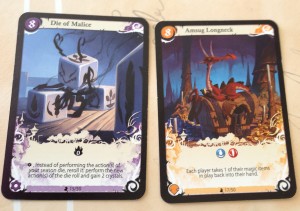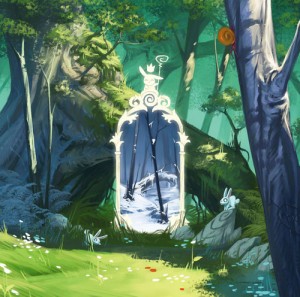Friday Night Unplugged #18: Seasons
- Updated: 5th Apr, 2013
Welcome back to Friday Night Unplugged as we return to our normal schedule by taking a look at one of new favourite games; Seasons.
Seasons is a dice/card/economy-management hybrid that takes the best of all three genres and mashes them into one.
“The greatest sorcerers of the kingdom have gathered at the heart of the Argos forest, where the legendary tournament of 12 seasons is taking place. At the end of the three year competition, the new Archmage of the kingdom of Xidit will be chosen from amongst the competitors.”
– Seasons Box
The Basics
Seasons takes place over three years with play moving between the four seasons for three cycles. Each player is tasked with earning the most crystals at the end of the game’s cycles.
- Each turn the first player rolls the dice relative to the current games season. Blue for winter, Red for autumn etc.
- Players then take it in turns to select one of the dice rolled and keep it.
- Starting again with the first player, everyone performs the actions marked on the dice in turn.
- Some icons gather energy of different types which can be used to summon cards from your hands.
- Cards can only be summoned if you have the space to cast them. Space is granted by star icons on the dice.
- Summoned cards are worth crystals at the end of the game and energy can also be transmuted directly into crystals.
- Whichever dice remains unpicked dictate how many spaces the season counter moves around the board.
- New cards can be drawn via dice rolls. Piles of cards set to one side at the start of the game are added to players’ hands with each completed year cycle.
- Whoever has the most crystals at the end of the game wins.
Lets Play
Jumping straight ahead of the setup for a 2 player game, me and Fi are playing with Fi on Orange and me playing Green. The cards have been drafted as per the instructions and split into piles. We even have an actual table to play on this time. The Luxury.
Rather than run through the full 3 years we’ll just be looking at the first year of our game. It’s enough for you to get a hang of the mechanics without dragging on the read-through too much.
The Long Winter:
As the one with the pointier ears, I get to roll and pick first. [Uh… okay. – Ed.] I take a dice that allows me to add one blue (water) energy and one red (feather, don’t ask) energy to my stockpile. Fi selects a dice that increases her summoning gauge and adds two blue water to her stockpile. The remaining dice move the season marker on by two places and we get one more dice roll this winter. Rolling first this time Fi adds 2 yellow (fire) energy to her stockpile. I gain 1 yellow energy and a notch up my summoning gauge and we move on into spring.
The Hard Spring:
Already mid-way through the spring cycle I roll and choose first, gaining two green energy and moving my crystal marker up by three. I also spend one blue and one red energy to summon a card from my hand; this earns me six crystals for being in play at the end of the game but bounces a played card back to my hand. I have no cards currently in play to bounce so it has no effect. On Fi’s turn she gains six crystals and spends two yellow energy to summon an Amulet of Fire into play. As its effect she gets to draw four new cards and keep one, discarding the others. The season marker moves along three spaces and moves us deep into summer.
The Short Summer:
Fi rolls and picks first. On her turn she gains one yellow energy and one green energy then follows up by summoning a Wondrous Chest for one blue and one yellow energy. This gains her crystals for having one energy in stockpile at the end of each turn. I gain one yellow and one green energy from the dice and follow up by playing a Dice of Malice that means I can re-roll any dice I pick. The track moves on two places, keeping us fully within autumn of the first year.
The Harsh Autumn:
The last roll of this year sees me scoring six points from my chosen die and Fi gaining yellow energy and another slot on her summoning gauge. The gauge moves on three and ends the first year. Fi is behind with 16 points to my 24 but anything can change over the next two years of play.
What Just Happened:
As you can see the seasons move on quite quickly. You need to think ahead when it comes to resource management and it’s relatively easy to draw new power cards to replace those you’ve played. For the record, at the end of the third year Fi beat my score by nearly 100 crystals.
What Is It?
Seasons is a game for 2 to 4 players and can play out in roughly 60 to 90 minutes. It contains 20 dice and hundreds of cards and tokens. While the cards are a little thin and rough to touch, the majority of contents are of a good quality. The artwork helps carry the light fantasy theme with pumpkin demons and other such creatures alongside hidden vales and other fantasy cards. On the whole as a product it’s superb. Seasons is published by Asmodee (Dixit, Jungle Speed) and sits perfectly alongside their range of innovative, family-friendly games.
What We Think
We’ve been interested in Seasons for almost a year. Every time myself or Fi stopped in our local game store to think about picking up something new we’ve often taken another look at the box for Seasons but never taken the jump. From the outside it looks… odd. The large circular central board covered in symbols. The strange custom dice that almost look like funky anime faces. Even the concept of a three-year cycle that blends economic management with pure luck just serves to build the pile of question mark tokens in your brain. If you ever see Seasons on a shelf then take a look and you’ll understand what I mean. Especially in these days when you’re not sure whether to hedge your bets and try something new or to stick with something you know you’ll enjoy.
Take that jump. While Seasons looks like an artist and designer designed a game at 2am after a few too many drinks Seasons is one of the most fluid and elegant games I have ever played. The seasons turn as relentlessly as they do in real life. Nature is yours to command and despite being a game where you need to think about what you’re going to do in your final year on the board your first year is equally as important. Once you get used to how all the gears fit together of course. Maybe it’s because of how the energy available transitions between seasons. In Winter Green spring energy is difficult to find and also more valuable to transmute into crystals. In Summer the red autumn energy is hard to get. It all just feels so naturally.
Amassing energy, summoning cards, transmuting energy into crystals. It’s a simple system and its playtime is perfect. 60 minutes for an average game is long enough to feel like you’ve played a decent length game but short enough that you want to play more. Even the dice look like cute abstract faces. Seasons is a game that wants to wrap you up in its world, a world of magic and amulets, weird familiars and a race to be the most powerful. I’ve played Seasons with four different people; Ellise enjoys boardgames but doesn’t actively play them often, Josh is picky about what he likes in a game and Fi doesn’t tend to like games that mean she has to think turns and turns ahead of herself. Seasons is one of the few games we have all agreed on. After all who doesn’t want to harness the power of nature itself.
Final Word:Seasons is a charming, elegant game that can be enjoyed with most people regardless of age (it advises 14+) or skill at games. You can buy Seasons at Travelling Man for £39.99.
Next Week
Next week on Friday Night Unplugged I’ll be going through the first of another two-parter. Like Eclipse before it, Runewars is a game of economic management, strategy and military might. It’s also a huge and complex beast so join me as I try to break it down ready for our play through the week after.








Follow Us!